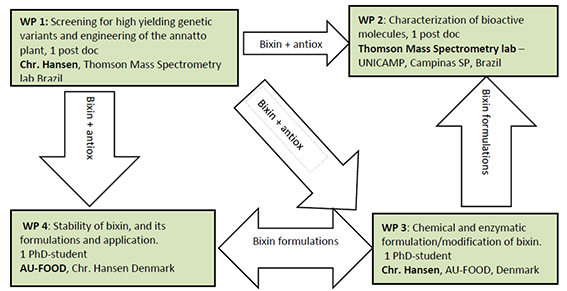
The market for natural colors is approx. 700M€ with growth rates in excess of 10% annually. A main market driver is reports on adverse effects of synthetic colors in children. Currently, 30% of food and beverage applications use natural colors. The major challenge for converting the remainder of the market away from synthetic colors is the additional cost and lower stability of naturally occurring pigments. Carotenoids are the preferred pigment group used for yellow and orange shades, representing 60% of the market volume. The annatto crop (Bixa orellana L.), that is endogenous to South America, can contain above 5% carotenoids in the seeds. This is 100-1000 times the concentration normally found in orange carrots, making Bixa orellana a promising production system for such pigments. The level of the two main carotenoids bixin and norbixin can vary significantly, typically from 1% to 5%, in different cultivated variants of the plant. By implementing systematic screening and optimized breeding the project’s first objective is to increase bixin and norbixin levels to 5-10%. A second objective is by the mean of mass spectrometry to find and characterize other valuable components, i.e. natural antioxidants. The third objective of the project is to increase the stability and applications of bixin and norbixin in foods. Both pigments are light and heat sensitive, and insoluble in water. Different formulation techniques will be utilized to enhance stability and functionality of these pigments and antioxidants in food and beverage applications. By optimizing both at primary production stages as well as increasing stability or applicability to a wider range of foods, this project can transform Bixa orellana to a sustainable bio-factory of natural colors for the food and beverage industries.
The objectives of the present study are 1) to assess and exploit genetic diversity to optimize the quality and yield of bixin and norbixin and other antioxidants, 2) use diverse mass spectrometry (MS) techniques to evaluate relevant bioactivity metabolite profile, quantification of bixin/norbixin, geranylgeraniol and tocopherol/tocotrienol in different annatto accessions, and in the beverages and food products developed, and last but not least 3) to improve the stability of these bioactive molecules in their final application through advanced formulation and more detailed insight into mechanisms for light- or heat-induced degradation of these pigments.
